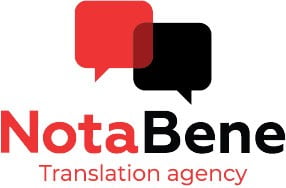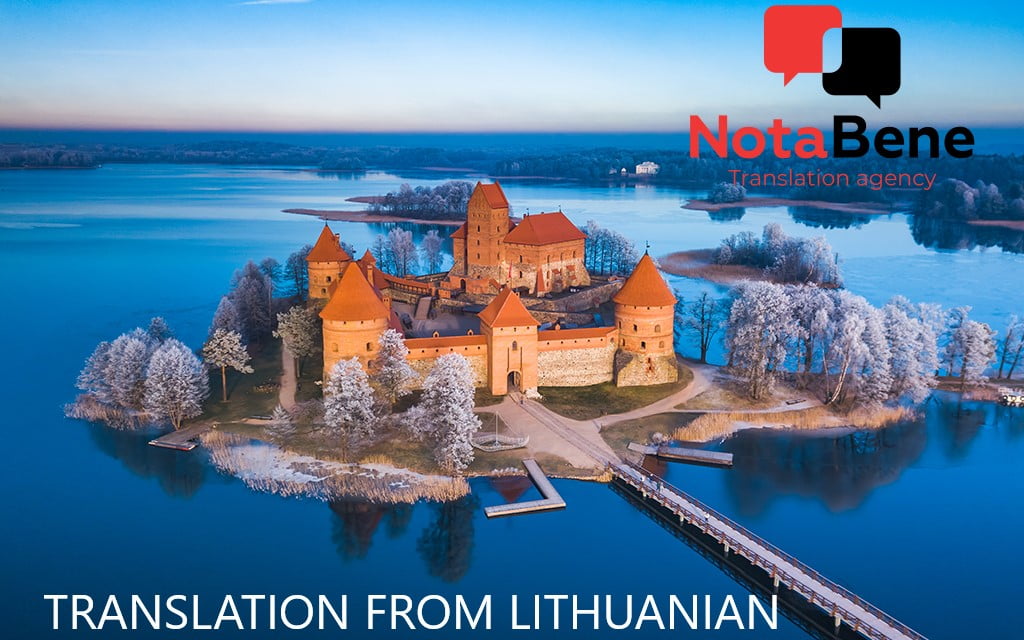Order translation from Lithuanian or into Lithuanian at Nota Bene Agency in Warsaw and Gdansk!
NotaBene Translation Agency is an experienced supplier of translation from Lithuanian into Polish and vice versa for any documents or texts.
What types of texts does NotaBene Translation Agency work with?
– Technical translation from Lithuanian— we translate any texts in electronics, aviation and shipbuilding, agriculture, industry, oil and chemistry, etc. For this purpose, we pick translators who understand the specific nature of a given industry.
– IT translation from Lithuanian for the localization of applications, games, software and websites.
– Medical translation from Lithuanian — books, manuals, articles in specialized printed and online publications, clinical records, correspondence with medical institutions, transcriptions and translations of test results, instructions for medicines and many other types of texts. This kind of translation requires flawless knowledge of medical terminology and focus on detail to rule out ambiguity, because the result can affect the health or life of many people.
– Legal translation from Lithuanian: statutes, registration deeds, articles of incorporation, contracts, powers of attorney, court records and many other similar documents.
– Financial translation from Lithuanian includes the translation of balance sheets, tax returns, payment invoices, waybills, tender documents, etc.
– Literary or fiction translation from Lithuanian of fiction, marketing and advertising materials. Unlike the previous types of translation, in this case there is more room for a translator’s creativity, because there is no need for “word for word” translation. The most important thing is that the translated material produces the same impact as the original, while an excellent translation may even make it better.
Please note that the translation mentioned is certified by an agency seal only. If you need sworn translation, kindly notify your manager in advance. Sworn translation is possible only for certain languages.
How to have a translation from Lithuanian into English, Polish, Russian, Belarusian or Ukrainian?
First of all, you need to order it. To do so, send your source text and specify your requirements for the translation from Lithuanian. A customer service specialist at the Nota Bene Translation Agency will prepare a ToR based on the specific features of the order. If the project involves more than one job, a unique glossary is created to ensure the consistency and proper use of terminology.
An entire team of several professionals normally works on a job: a translator, proofreader, editor, quality controller, layout designer and manager who will be available during working hours. In order to rule out human errors, the translation agency uses modern services to check punctuation, idioms, numerical expressions, and formulas. The material is also reviewed by the chief editor.
Confidentiality of translated data is ensured by a special NDA, whenever a customer wishes to have one. Documents can be delivered to any country.
We very rarely apply additional fees for “urgency” or “specialized subjects”, so you can be sure that the price will not rise when the project is delivered. It is true that in rare cases, such as “we need to have it yesterday” instances, and when a customer is willing to pay a higher rate for the team to work outside normal working hours, at night or on weekends, the fee might be increased, but this is always negotiated with the customer in advance.
Exciting facts about the Lithuanian language
Lithuanian belongs to the group of Baltic languages. It is the official language of Lithuania and one of the official languages of the European Union. It is currently spoken by more than 3 million people, both in Lithuania and abroad. The Lithuanian language is unusual, difficult to learn and just incredibly interesting. This is evidenced by the following facts.
- Many philologists believe that Lithuanian is the oldest living language. The fact is that phonetically and morphologically it is most similar to the Proto-European language, from which all modern European languages are derived. “Anyone who wants to know how Indo-Europeans spoke must listen to a Lithuanian peasant,” French linguist Antoine Meyer once said. Therefore, in reconstructing the Proto-Indo-European language, specialists rely primarily on Latin, Sanskrit, Greek and Lithuanian.
- The Lithuanian language is very similar to Sanskrit. The reason for the similarity is not their affinity (these languages belong to different groups), but the large number of Proto-European elements preserved in them. Lithuanian and Sanskrit have similar grammar and many similar words in pronunciation and meaning.
- Historically, the Lithuanian nation consisted of four ethnic groups. Aukštaitians live in the north, Samogitians in the west, Dzūkians in the southeast, and Suvalkians in the south. Each of these ethnic groups has different external features, customs, traditions and dialects. Up until 150 years ago, the differences between the ethnic groups had been so great that, for example, Samogitians did not understand the Suvalkian dialect at all. Only the modern literary Lithuanian language, which was artificially created in the late 19th century on the basis of all the four dialects, bridged the differences.
- The first written mention of the Lithuanian language was a manuscript entry on the last page of the book Tractatus sacerdotalis, published in Strasbourg in 1503.
- The family status of Lithuanian women can be easily understood from the ending of their names: the surnames of unmarried women end in -aitė , -iūtė or -ytė, and those of married women in -ienė. Recently it has become fashionable for celebrities to add the ending -ė to their names, which does not indicate whether they are married or not.
- The Lithuanian language has an extraordinary vocabulary, which in terms of lexicology is almost invaluable. The number of foreign words used in speech is carefully regulated by a State Commission established for this purpose. Wherever possible, borrowed words are replaced by their Lithuanian equivalents. However, despite all efforts, the influence of English is becoming more and more noticeable.
- There are almost no curse words in the Lithuanian language. For example, one of the most coarse curses is rupūžė, which translates as the “toad”. If Lithuanians want to curse, they use English words and expressions.
- Many 30+-year-old Lithuanians still remember the Russian language, but as a rule they do not want to use it. However, you can hear filler words such as “as if”, “you know what I mean”, or “in any case” in their speech. The older generation may still use Russian. Most young people under 30 do not even understand Russian.
- There are many diminutive suffixes in Lithuanian. For example, “baby” in Lithuanian is vaikas, but “child” can be translated in different ways — vaikelis, vaikiukas, vaikeliukas, vaikelėlis, vaikužėlis, vaikučiukas.
- The longest word in Lithuanian is nebeprisikiškiakopūsteliaudavome, which translates as “We used to pick wood sorrel in the past for ourselves regularly but not anymore”.
- The phrase “Do you get off here?”, uttered by passengers on public transport, is “arJūslipsitečia?” (arjūslipsitečia?). But Lithuanians have greatly simplified and changed it. And that’s why in all buses and trolleybuses today you can hear “Lipsi, lipsi, čia-čia-čia” (Lipsi, lipsi, cha-cha-cha).








